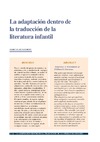Identificador persistente para citar o vincular este elemento:
https://accedacris.ulpgc.es/jspui/handle/10553/7533
| Título: | La adaptación dentro de la traducción de la literatura infantil | Otros títulos: | Adaptation in Translations of ChildrenÆs Literature | Autores/as: | Pascua Febles, Isabel | Clasificación UNESCO: | 570112 Traducción 570108 Lenguaje infantil |
Fecha de publicación: | 1999 | Publicación seriada: | Vector Plus | Resumen: | Tras el estudio del género de cuentos y su
estructura, y de la ampliación del concepto
de «intertextualidad cultural», se realizó el
análisis comparativo-contrastivo de las
convenciones textuales de los cuentos
españoles e ingleses, pudiendo así evaluar
las traducciones de los cuentos ingleses de
animales. Tras ello, demostramos que las
adaptaciones pueden dividirse en tres tipos:
necesarias, admisibles e inadmisibles. Y
ello, a partir de la no coincidencia de los
conocimientos cognitivo-culturales, de las
normas de comportamiento verbal y no
verbal, y de las convenciones textuales.
El interés científico de nuestro trabajo
consiste en que, además de ser el primero
en analizar y evaluar las traducciones de
cuentos infantiles, su principio
metodológico puede aplicarse a cualquier
otro tipo de texto, y a la didáctica de la
traducción, abriendo nuevas líneas de
investigación. El interés social está en que
es un trabajo muy útil, sirviendo de pauta
y de orientación a los traductores
profesionales a la hora de traducir
cuentos de animales al español, desde
cualquier idioma, no sólo inglés. The genre and structure of popular tales for children were subjected to analysis and the concept of æcultural intertextualityÆ was broadened to englobe the same. Thereafter, a comparative-contrastive analysis of the textual conventions observed in Spanish and English fairy tales for children was carried out. This allowed a qualitative evaluation of the Spanish translations of English tales. The adaptations were grouped into three categories: necessary, passable and completely inadmissable, according to the degree of cognitive- cultural coincidence, norms of verbal and non-verbal behaviour and textual conventions. The scientific interest of the work consists in its applicability as a methodology to all other types of texts, thus making it a valuable tool for the teaching of translation whilst also opening up new fields of research, not only restricted to the translation between Spanish and English. |
URI: | https://accedacris.ulpgc.es/handle/10553/7533 | ISSN: | 1134-5306 | Fuente: | Vector Plus [ISSN 1134-5306], n. 13, p. 36-47, (1999) |
| Colección: | Vector plus. n.13, 1999 Artículos |
Visitas
863
actualizado el 11-ene-2025
Descargas
2.075
actualizado el 11-ene-2025
Google ScholarTM
Verifica
Comparte
Exporta metadatos
Los elementos en ULPGC accedaCRIS están protegidos por derechos de autor con todos los derechos reservados, a menos que se indique lo contrario.
